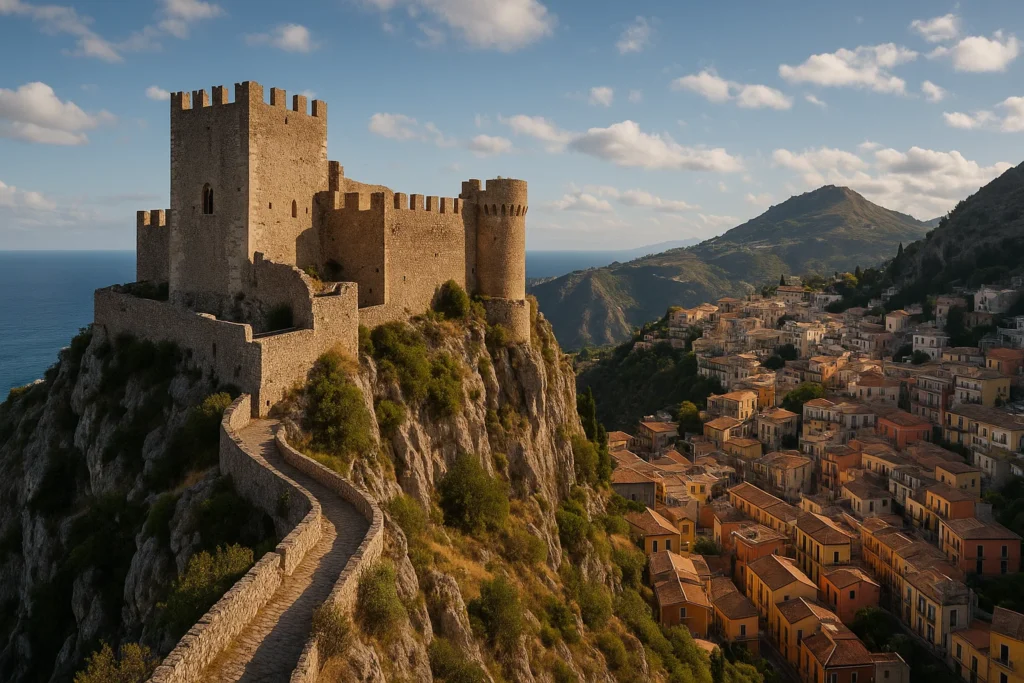The Saracen Castle of Taormina is one of the most evocative testimonies of Sicilian medieval history, located on a hill overlooking the town and offering spectacular panoramic views of the sea and Mount Etna. Its strategic location, controlling the Ionian coast, made it essential for defending against Saracen pirate raids and overseeing maritime traffic.
The castle’s construction likely dates back to the Norman period, around the 11th century, although earlier fortifications may have existed during the Byzantine era. The name “Saracen” comes from the many battles and raids involving the Saracens—Muslim pirates who plagued the Mediterranean. The castle served as a lookout and defense point, with strong walls and watchtowers controlling the horizon.

Over the centuries, the castle was modified and expanded several times, passing through the hands of various rulers and governments. Today, it partly stands as a ruin—a place steeped in charm, retaining the atmosphere of ancient fortifications. Walking among the ruins, one can imagine sentinels scanning the sea for signs of danger and almost hear the waves crashing against the rocks below.
The Saracen Castle is located in the upper part of Taormina, just a few minutes’ walk from the historic center. To reach it, one can start from Piazza IX Aprile, the city’s vibrant heart, and follow an uphill path that leads to the castle, surrounded by Mediterranean vegetation. The walk is pleasant and offers unique glimpses of the town and the coastline below.
Among the most intriguing curiosities is the legend that the castle may still conceal buried treasures or secret passages, fueling the imagination of visitors. Furthermore, excavations have unearthed remains of ancient structures and artifacts that reflect the site’s long military and civil history.
Visiting the Saracen Castle of Taormina means immersing yourself in a piece of authentic history, enjoying unforgettable views and breathing in the atmosphere of a place that has witnessed eras of war and peace, mystery and legend.

Beyond its strategic and defensive role, the Saracen Castle of Taormina is today an unmissable stop for anyone wishing to explore Sicily’s medieval history in a breathtaking natural setting. Its panoramic position allows visitors to admire not only the town’s skyline but also the grandeur of Mount Etna, the Ionian Sea, and, on clear days, the Aeolian Islands on the horizon.
Although now partly in ruins, the castle still preserves traces of the old walls and towers that once protected the inhabitants. During the Norman and Swabian eras, the fortress was expanded and improved to fend off frequent pirate attacks, which posed a constant threat to coastal communities. Over time, the site gradually lost its military importance with the consolidation of Spanish rule and the development of new fortifications.

Another fascinating aspect is the castle’s historical use as a refuge for the local population during sudden attacks. Its thick walls and elevated position made it a safe place to monitor enemy movements and organize the area’s defense.
For visitors to Taormina, reaching the Saracen Castle is also a rewarding hiking experience. The walking route from the town center, through charming alleys and scenic views, reveals hidden corners of the city and offers breathtaking vistas that unfold as you climb the hillside.
The castle is rich in curiosities: some scholars speculate that beneath its foundations may lie underground tunnels used to communicate with other strategic points in the city, while popular legend speaks of ghosts and mysterious presences that haunt the fortress’s silent nights.
In short, the Saracen Castle of Taormina is much more than a mere medieval ruin—it’s a place that tells stories of battles, defense, daily life, and mystery, offering visitors a journey through time immersed in one of Sicily’s most stunning landscapes.
The Saracen Castle of Taormina, beyond being an important defensive structure, represents a crossroads of different historical periods that overlapped over the centuries. The first traces of fortifications on the hill likely date back to the Byzantine era, when the island of Sicily was contested by various peoples and effective defense against external incursions was necessary. With the arrival of the Normans in the 11th century, the structure was expanded and transformed into a true military fortress, suitable for controlling the coast and protecting the town from Saracen attacks—from which the name “Saracen” derives.
During the Swabian and Angevin periods, the castle retained its strategic function but was also adapted to house military garrisons and serve as a local administrative center. Interestingly, in the Middle Ages, the castle was not only a military stronghold but also a symbol of feudal power, often inhabited by the local lords who ruled the area. This made it a place of great importance not only militarily but also socially and economically.
With the advent of Spanish rule in Sicily from the 16th century onward, the castle’s defensive role began to decline in favor of newer, more modern fortifications better equipped to withstand firearms. Consequently, the Saracen Castle entered a gradual decline, becoming partly a ruin while still remaining a reference point for the city’s historical memory.
A historical curiosity is that, during periods of war and turmoil, the castle also served as a prison or detention site for war prisoners and political opponents, adding another layer of mystery and allure to its story.
Today, beyond being a major tourist attraction, the Saracen Castle is the subject of archaeological studies and restoration efforts that aim to preserve its remaining structures and deepen understanding of its origins and functions. Visiting it allows you to walk through a piece of history that tells the story of Sicily’s successive dominations—from Byzantine to Norman, Swabian to Spanish—all testified by the stones of this ancient fortress.
